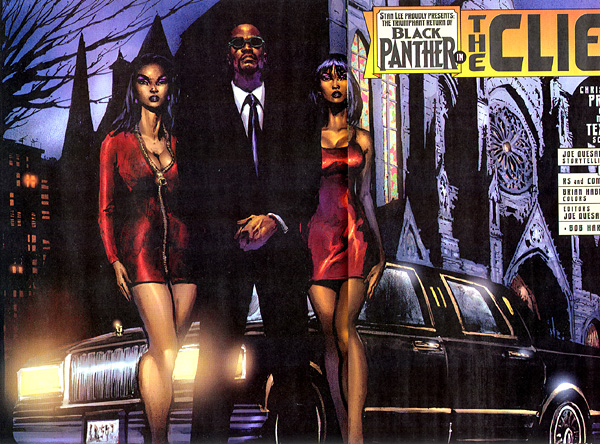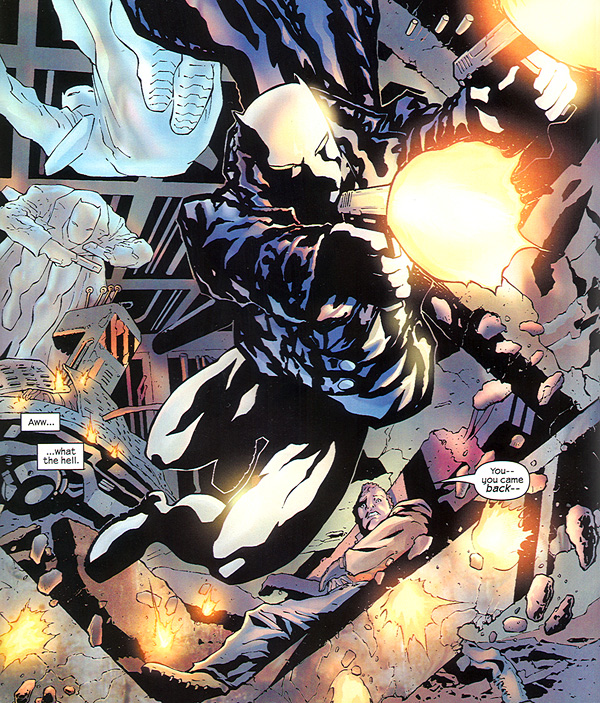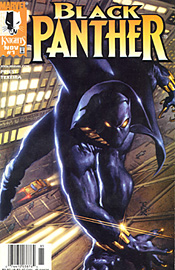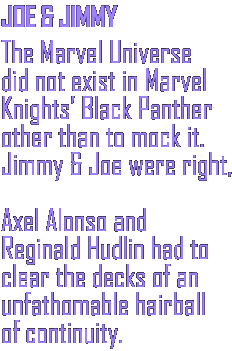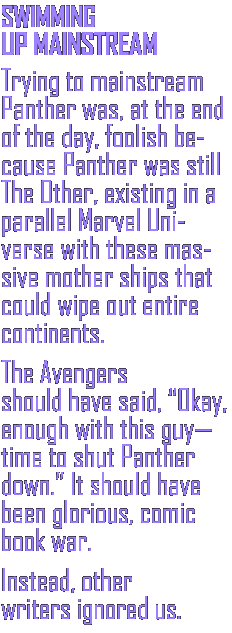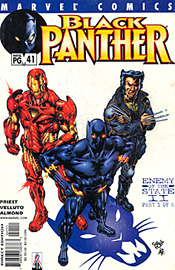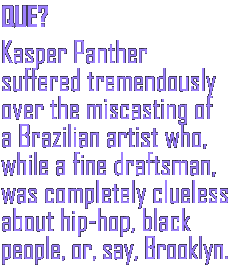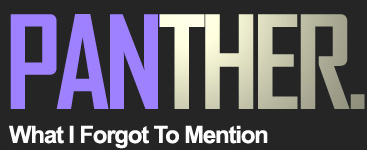
And Another Thing...
I’m sure I’ve said everything there is for me to say about
Panther over on
the old site, but I did want to add this coda. I
was looking through some old comics the other day, came across
the Panther/Storm two-fer, started reading and couldn’t
understand a word of it. I mean it. There was this kid, Vibraxas,
and his back-story, there was a bunch of business with Lord Gaur
and the Eternals, whoever they were, and a pot-bellied SHIELD
agent about to start World War III by hunting these folks down.
The White Wolf, whom I liked quite a bit, was using Vibraxas to
resurrect Klaw, so I needed to explain who the White Wolf was
(The Panther’s adopted brother, his Reverse Flash) and who Klaw
was (the man who created The Black Panther when he murdered
Panther’s father, T’Chaka—wait, now I have to explain who
T’Chaka was). Then there were all of these side characters
running around—Queen Divine Justice and Panther’s staff. There
was so much plot, the brilliant Sal Velluto’s art was routinely
suffocated by having been constricted to six panels on a page,
which I covered with Ross’s chattering (explain who Ross is). I
couldn’t read it. It was a mess. I flopped down on my sofa and
thought, “What the hell was I thinking?”
Comics have gotten simpler and, in many ways, dumber ever since.
We no longer tell stories but tell fragments of stories. A story
we once told in an issue takes three. Once, doing a two-part
story required special permission, now the request is for story
“arcs” because not many of us can actually tell a story anymore.
This is a frustrating way to write, to not be able to give the
audience a story but only a fraction of one part of the story,
and then make them wait four weeks for the next piece. It would
be different if we published weekly, say, a big block of paper
with multiple serials running in it. But, last time I paid any
attention to this, the art form of writing had been all but
wiped off the written page in favor of beautiful pictures, 22
pages of awesome graphics that move the plot along at a snail’s
pace.
In the beginning, editors Joe Quesada, Jimmy Palmiotti and Nanci
Dakesian carefully steered me away from the Marvel Universe. The
Marvel Universe did not exist in Marvel Knights’ Black Panther
other than to mock it. Those were not their words, but that was
surely their sensibility. The Marvel U can drop in just as long
as we insult the fans by having T’Challa punch out Mephisto soon
as he encounters him. Joe, Jimmy and Nanci were perfectly
content to have Panther exist in the Pantherverse and to not
burden the series with too many channels to the mainstream. In
hindsight, they were right. When new editor Axel Alonso brought
in former BET president and feature film director Reginald
Hudlin to reboot the series, they rightly cleared the decks of
an unfathomable hairball of continuity. I love continuity, I
love complexity. Neither worked very well with Sal’s classic,
gorgeous art, which really deserved a lot more room than I gave
him. I was also slavishly reverent of past writers Kirby and
McGregor and resolutely determined to validate every inch of
T’Challa’s previous continuity, which was fun for the fanboys
but explaining all that stuff was like New Reader Repellent. I
was incredibly frustrated to learn Marvel had no plans to
repackage the remaining Panther issues, especially Enemy of The
State II, Seduction Of The Innocent, Sturm Und Drang and other arcs, and spoke to Joe about it who said,
rightly, that they were promoting a new Panther, now, ReggiePanther, and having that other stuff out there would split
an audience they were trying to build. And, in a finger snap, my
Panther ceased to exist, which, I suppose, it had to—I’d not
left Marvel much alternative. But it was a big hit to take.
Getting It Right:: Quesada/Palmiotti vision of Panther existing outside of the Marvel U.
New Directions
The other thing I wanted to mention is, at least back in those days, at Marvel, you worked for an editor. Now, some names are so huge they get to do whatever they want. But, traditionally, it is the editor who sets the creative direction for a series and who leads the creative team. I would routinely get lambasted online about whatever fans didn’t like about the series, but there seemed to be no allowance made for the fact that creative direction changes in the series tended to coincide with changes in the editor’s credit. Mike Marts’ Panther differed from Tom Brevoort’s differed from Ruben Diaz’s differed from Joe and Jimmy’s. In retrospect, Joe and Jimmy’s Panther was the right Panther, which is likely why Axel and Reggie moved somewhat in that direction. There were simple lines, clean lines, in Quesada’s vision for the book. Whatever numbers it did were simply a consequence of the marketplace and the book finding an audience. Once Jimmy and Joe sent Panther back to the Marvel Universe, we began a five-year, relentless uphill turd roll trying to get the numbers to move. They never did. Black Panther will sell whatever it is Black Panther sells. Landing John Romita Jr. for ReggiePanther was a genius move (as was landing Hudlin himself, for whom Panther was and remains a labor of love). But, absent star power, Panther will do whatever numbers it does. We never should have gone chasing the numbers. Publish or cancel it, This Is What This Book Is.
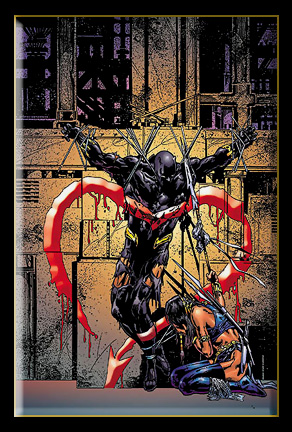 Instead, Panther went through numerous
Instead, Panther went through numerous
personality shifts,
beginning with Ruben Diaz’s insistence we “mainstream” the title
more, tossing in guest star after guest star and taking a fresh
look at how Panther is seen by the Marvel U. Without changing
continuity, we changed Panther’s motivations, which offended
both the Avengers and the readers to some extent. Rather than
mocking the Marvel U, Ruben loved poking it with a stick. A
brilliant and underrated editor, Diaz and I had previously spent
a year or so mocking the DC Universe with Justice League Task
Force, a kind of JLA SEAL team whose premise was the JLA would
send them on special assignments or to follow up after JLA
engagements. Only, the JLA guys never once cooperated. They
never sent the Task Force on any missions. So Ruben and I wrote,
essentially, Kirby’s X-Men: young superheroes who get on each
other’s nerves. Our unstated goal was to see how long we could
get away with not actually giving the Task Force an official
mission before somebody at DC noticed. They never did. Task
Force’s numbers, while not spectacular, were more than enough to
keep us going until the Grant Morrison JLA reboot.
Tom Brevoort, whom I consider to be the best editor working in
comics these days, was a much less angry young man than Ruben.
Tom issued no mandates, was not heavy handed about Panther. Let
Panther Be Panther, he said, that, essentially, the book was so
closely connected to me that Tom was content to allow my
personality to drive the creative direction. Under Tom, we were
no longer poking the Marvel U with a stick but trying to
integrate peacefully as a mainstream comic. In retrospect, this,
too, was sort of wrong. Not that Panther should not interact
w/the Marvel U, but I really needed pushback from the Marvel U
to validate what I was doing in Panther. I mean, Panther annexed
Canada and stole Stark Industries—a real center of national
security concern—with a single phone call. Somebody, somewhere
else in the Marvel U, should have noticed that. Panther revealed an
unthinkable military capacity for Wakanda—and nobody else
anywhere else in the Marvel U had even a single concern about
it. Which, of course, was ridiculous. Panther’s relationship
with the Avengers had grown contentious and they were (at least
in Panther’s book) openly suspicious of him and his motives if
not fearing outright for his sanity. But none of this was
reflected back at us from mainstream Marvel books, many of which
Tom oversaw. Trying to mainstream Panther was, at the end of the
day, foolish because Panther was still The Other, existing in a
parallel Marvel Universe when, to be true to continuity, by the
time Panther revealed these massive mother ships that could wipe
out entire continents, the Avengers should have said, “Okay,
that’s enough—time to shut this guy down.” Instead, other
writers ignored us, ignored the universe-spanning implications
of what we were doing.
Tiger Power:: Bennett gets Kasper right in The Crew.
The Friendly Ghost
By the time Mike Marts inherited the book, we were under siege.
It was all about the numbers. I was exhausted from trying to
attract new readers and I felt like we’d been constantly chasing
new readers at the expense of the loyal ones we already had. I
felt like going after new readers was a waste of time: people
knew what this book was, had read the reviews, knew my name,
knew who Sal and Bob were. They either bought it or didn’t. But
we were tasked, repeatedly, to stunt-up the book with “jumping
on” points. The problem is, convenient jumping-on points are
also convenient jumping-off points. There was no traction, and
Mike and I discussed this at length, concluding the only way to
jazz up Panther would be to separate Panther from me. It wasn’t
Panther per se the reader were giving a pass to, it was likely
the convolution of plotlines and density. With my knowledge,
Mike started shopping for writers.
A decision was made, I’m not sure by whom, to try something
else: revamping the character altogether and losing the West
Wing-style superhero politics, which required complexity and
perhaps too much investment from the readers. I believe that was
their pitch to the prospective writers: come up with a new,
hip-hop relevant Panther. Remove T’Challa, put him on a bus or
what have you, and wheel in the new guy. For whatever reason,
the selection choice turned back to me. I wasn’t overly thrilled
about the idea, but I thought I might have a way to go. Blending
the dynamics of Stan’s early Spider-Man, I created a new
character who finds one of Panther’s old costumes left in an
alley. Dan Fraga was brought in for the art and Andy Kubert was
put on covers. We were given, I believe, a year to make Kasper
Panther work, but he never caught on. The book still had my name
on it, and the change may have come across as a desperate move
on my part to keep my job at the expense of T’Challa’s rich
legacy. Also, Dan Fraga departed after a single issue, and
Kasper Panther suffered tremendously over the miscasting of a
Brazilian (I believe) artist who, while a fine draftsman, was
completely clueless about hip-hop, black people, or, say,
Brooklyn. Kasper Panther, which was supposed to be an edgy,
hip-hop thing, looked like it was being drawn by Sal Buscema.
Sal is a brilliant artist, but he would not have been my first
choice for a comic book that was supposed to resonate with Vibe
Magazine or XXL. I struggled and over-wrote to compensate,
trying to get the words to do what the pictures abysmally failed
to, but from my desk, Marvel had given up on Panther and was
just running out the clock. The first time Kasper Panther ever
breathed real life was when artist Joe Bennett electrified the
concept over in The Crew. I remember seeing Bennett’s first
pages with Kasper, thinking, “This is what Mike (Marts) asked me
to do in the first place.” Bennett, also no hip-hopper, was
nonetheless ingeniously intuitive. Despite the language barrier
(Joe was from Spain, I believe), Bennett brought the Crew
scripts to life with verve and energy sorely lacking from the
Kasper Panther issues.
I was chatting with Reginald Hudlin last month and told him I’d
only read, I believe, the first issue of his Black Panther. It
wasn’t that I resented him in any way or that I was jealous or
angry. Axel and Reggie did what needed to be done and did so
brilliantly. I don’t go to comics shops and I’ve been way out of
the loop about what’s been going on, but, from what I can tell,
Panther has enjoyed several iterations beyond Hudlin's and has
found more acceptance and popularity (if nit quite outright
stardom) in the Marvel Universe than ever before. This is
heartening, and I will take some credit, along with Stan and
Don, for whatever part my creative contributions played.
Christopher J. Priest
21 September 2011
Home | Blog | Projects | Comics | Rants | Music | Video | Christian Site | Contact
The Black Panther Copyright © 2011 Marvel Productions. All Rights Reserved.
Text Copyright © 2011 Lamercie Park. All Rights Reserved.
TOP OF PAGE

